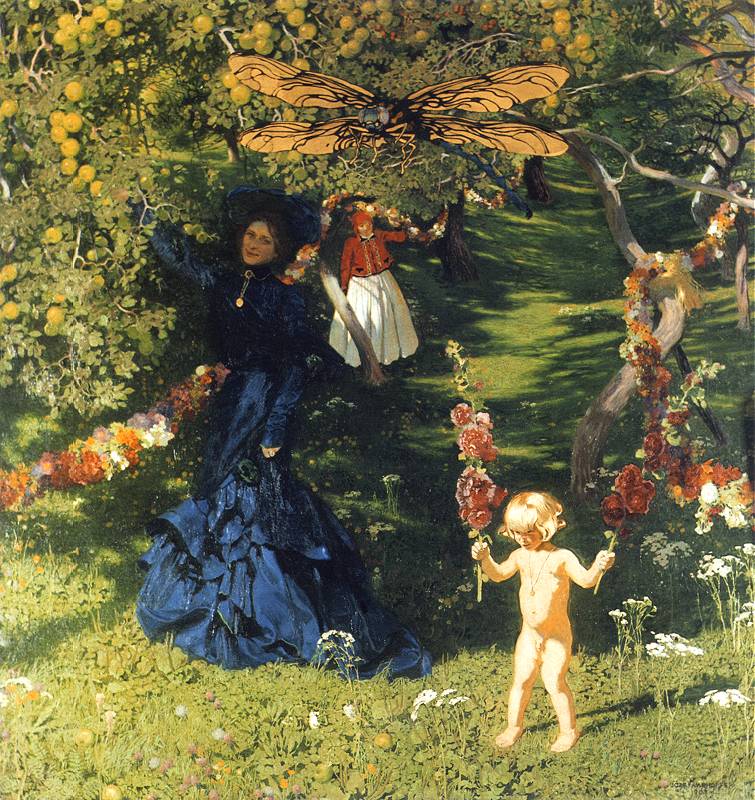 Dziwny ogród.
Dziwny ogród.1903. Olej na płótnie. 217 x 208 cm.
Muzeum Narodowe, Warszawa.
Mehoffer, Józef (b Ropczyce, nr Rzeszów, 19 March 1869; d Wadowice, nr Kraków, 8 July 1946). Polish painter, printmaker and decorative artist. From 1887 he studied at the School of Fine Arts in Kraków under Wladyslaw Luszczkiewicz (1828–1900) and Jan Matejko. In 1889 Mehoffer and Stanislaw Wyspianski, as the two most talented pupils of the School, were engaged to assist Matejko in his decorative wall paintings for the Gothic Church of St Mary in Kraków. This work aroused Mehoffer’s interest in both fresco and stained glass. In 1889–90 he studied at the Kunstakademie, Vienna, and in 1891 he travelled through Salzburg, Innsbruck and Basle (where the work of Arnold Böcklin caught his imagination), eventually going to Paris. There he studied at the Académie Colarossi, at the Ecole Nationale des Arts Décoratifs and, from 1892, in the atelier of Léon Bonnat at the Ecole Nationale des Beaux-Arts. During his stay in Paris (1891–6) he devoted much time to studying works by the Old Masters in the Louvre; he also studied architecture, making a tour of medieval cathedrals in France in 1893. He took an interest in current history painting and exhibitions of contemporary art, especially the paintings of Pierre Puvis de Chavannes and James Abbott McNeill Whistler. Mehoffer’s early works, such as Maternity (1894), Objects on a Mantelpiece (1895; both Poznan, N. Mus.) and Dance Naive (1898; Kraków, N. Mus.), inspired by a theme from Paul Verlaine’s poem Les Ingénues, reveal the extent to which he had absorbed the characteristics of the Nabi artists, to whom he was drawn for their tendencies towards decorative synthesis, refined stylization and tasteful tonality. Mehoffer employed an expressionistic variant of Symbolism to create an atmosphere suggestive of unease and impending disaster, as in the painting The Ravine (La Gorge de Reusse, 1897; Poznan, N. Mus.), as well as in the several versions from this period of The Muse (e.g. Warsaw, N. Mus.). ___________________________________________________________Jeden z czołowych przedstawicieli Młodej Polski. Twórczość Mehoffera kształtowała się pod wpływem wiedeńskiej secesji i średniowiecznego francuskiego malarstwa witrażowego. Cechami stylu Mehoffera są: dekoracyjność linii i koloru, soczysta gama barwna, zamiłowanie do złoceń i ornamentów oraz wprowadzanie motywów ludowych, alegorycznych i symbolicznych. W twórczości Mehoffera główne miejsce zajmują witraże i polichromie ścienne, należące do najwspanialszych osiągnięć sztuki dekoracyjnej w Polsce: 13 witraży w katedrze we Fryburgu szwajcarskim (1895 - 1936), witraże katedry wawelskiej (1902 - 1925), polichromia skarbca na Wawelu (1901). Malował obrazy symboliczne (Dziwny ogród 1903), wnętrza (Majowe słońce 1911), liczne portrety (wizerunki żony, autoportrety, Śpiewaczka 1895). Mehoffer projektował meble, dekoracje teatralne, wnętrza. Uprawiał grafikę użytkową. Encyklopedia Powszechna PWN, Warszawa 1975
Malarze i graficy
Kompozytorzy
Filozofowie |
| .................................................................................. |
Brak komentarzy:
Prześlij komentarz